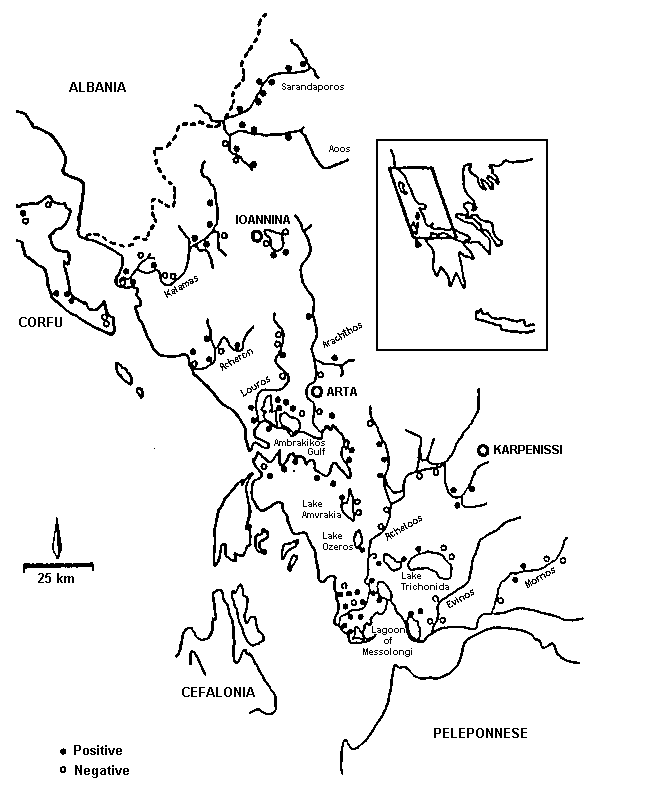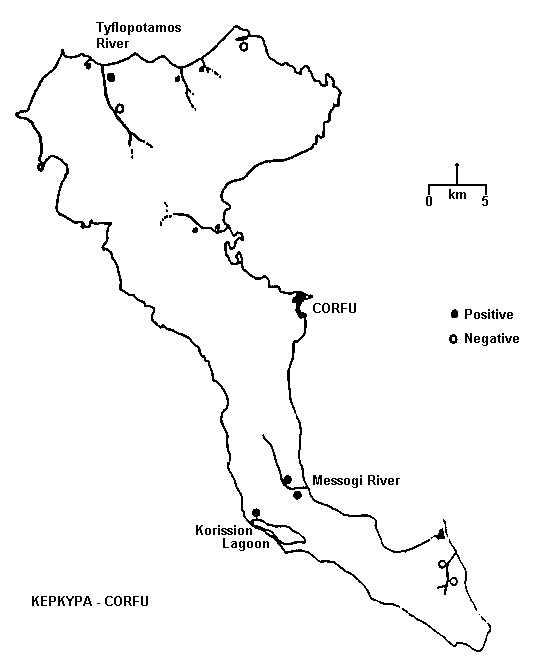 |
Last Update:
Friday November 23, 2018
|
| [Home] |
|
Volume 3 Pages 1 - 51 (March 1988) Citation: Gaethlich, M.. (1988) Otters in Western Greece and Corfu. IUCN Otter Spec. Group Bull. 3: 17 - 23 Otters in Western Greece and Corfu Martin Gaethlich 42, Neighy Str., Ano Palissia, 111.43 Athens, Greece INTRODUCTION Recent field surveys in Eastern and North Eastern Greece proved the presence of healthy otter populations (Macdonald and Mason 1982 & 1985). However the information available on the distribution of the species in Western Greece was limited. (Reuther and Festetics 1980). This report presents the preliminary results of a field survey currently underway in this area. It also includes the results of a similar study in Corfu. STUDY AREA Western Greece, with eastern edge Pindos mountains, occupies an area of 17,500 km2 and is divided in two major regions: Epirus and the west-central mainland. Both are primarily mountainous with only a few plains, the most important being those of Arta, loannina, Kalamas Delia, Messolongi and Agrinion. In the lowlands, agriculture is largely arable. Maize, cotton, tobacco and clover are the main cultivated crops in the irrigated plains. Oranges, lemons, olives and wheat are also locally important. Since the 1970s, land reclamation and mechanization have been advancing rapidly. particularly in the lowland and coastal areas. Goat and sheep grazing is widespread while cattle grazing is rather local and generally in small numbers. It should also be noted that during the last decade large pig units have been installed throughout the country and in some areas (e.g. Northern Ambrakikos area) are responsible for severe organic pollution of waterways. Although deforestation due to overgrazing and fires has denuded the major part of the Greek countryside. W. Greece and especially the N and NW part could still be considered well wooded. Throughout Greece most of the major rivers have been harnessed for hydroelectric power. In contrast Sarandaporos, Kalamas, Acheron and Evinos are among the few remaining rivers with HEP dams. The dam in Mornos River forms a reservoir which supplies Athens with drinking water. Some river beds are used for sand and gravel extraction, but large scale exploitation is limited to a few places. In Western Greece there are also a few natural lakes most of them eutrophic, but still free of toxic (or persistent) pollutants. Corfu occupies an area of 592 km2. The economy of the island (with a population of 99,477 inhabitants in 1981) is largely dependent on tourism. Olive groves cover the major part of the agricultural land while orchards and gardens are less widespread. METHODS The survey is divided in three parts: in the first carried out between June 1985 and March 1986, the interest was focussed in the lowland plains and two pilot areas (Ambrakikos gulf and Messolongi area) have been selected for a further comparative study. During the second part, which lasted from April 1988 till March 1987 all stations in the pilot areas were regularly visited and also many suboptimal upland habitats were searched for otter signs. This second part included a survey in the island of Corfu which was carried out between 1 and 6 of May 1986. There is also a third part, still in progress, which includes surveys in restricted upland habitats and in some other Greek Islands. During the first and the second part, a total of 106 sites in W. Greece and of 8 sites in Corfu were visited including rivers, streams, drainage ditches, lakes and marshes. Stations were chosen for ease of access e.g. a bridge, or a place where a river ran close to a road etc. At each station a minimum distance of 200m of bank was searched for spraints and footprints of otters, and the species was assumed absent if no signs were found after a search of 600m. Notes were made on visible pollution, disturbance etc. Spraints were collected from sites distributed throughout the study area, with a special interest in the two pilot areas, for further examination. The study on the diet of otters in W. Greece will be concluded by the end of spring 1988. In addition, a sample of spraints will be analyzed with collaboration with the National Center for Marine Research for heavy metals as described by Mason and Macdonald 1986. RESULTS
In W. Greece 106 sites were visited in total and otter signs were found at 70 (66%). In Corfu 8 sites were searched and otters were present at four.
A further five sites indicated on maps as perpetually flowing streams were found dry. In Epirus 35 of 52 stations proved positive (67.3%). Sarendaporos is the only river with no negative stations. In the Aoos catchment 71.4% of the stations produced signs of otters. Kalamas proved to be less favorable, with 58.3% positive stations. At three out of five negative sites of this river, sand and gravel extraction was the only serious disturbance factor, and in two sides the impact on the riparian vegetation was significant. In this region the presence of otter signs seemed to be strongly associated with good bankside condition. It should be mentioned that otters were present even in loannina lake, near the city of the same name (with a population of 44,829 inhabitants according to 1981 records), but were isolated in the southern and eastern part of the lake, where tracts with dense reedbeds still exist. In the plain of Arta (Northern Ambrakikos gulf) 80% of the stations proved positive. In this area drainage ditches and canals comprised the 50% of the positive sites. In Ambrakikos gulf otters have also been found in both brackish and coastal habitats. The same was observed in Messolongi area where otters occur in the lagoons of Aetoliko and Klissova. In the whole area of Messolongi wetlands (including Messolongi lagoons, lower Acheloos and lower Evinos) 73.7% of the stations produced signs of otters. As in the N. Ambrakikos area, otters were frequently found in drainage ditches. In this kind of habitat brambles (Rubus sp.). reeds and reedmace play an important role by providing shelter and cover. Similar irrigation ditches with this kind of bankside vegetation are also typical for NE Greece (Macdonald and Mason 1985). It is remarkable, however, that otters are absent from HEP reservoirs as is also recorded from similar surveys in Portugal (Macdonald and Mason 1982b). There was only one exception in Louros dam where otters were present in the reservoir. In this particular reservoir bankside cover consisted mainly of dense beds of reedmace. On the other hand otters exist in all natural lakes of Western Greece. During the second part of the survey some of the sites previously thought negative proved to be positive. This may suggest that otter populations in these places are not resident or that the species exist at a very low density. Another point which should be taken into account is that at places where bankside vegetation was very dense (sometimes impenetrable), the 600m. searching distance was rather inadequate. Rain and flooding further impair this problem. However, regular visits seemed to insure reliable results. Measurements of tracks, found on mud or sand, indicate in several cases the presence of otter cubs (tracks less than 45mm across the five toes). Cub tracks were found at six sites (three of them in lowland and three in upland habitats). In particular, cub footprints have been found in the lower and upper Acheloos in the Eastern Ambrakikos gulf. In the lower Kalamas, in Aoos and in Sarandaporos, bankside vegetation on 4 of the above sites could be considered as good while in the rest two sites, as moderate. DISCUSSION Western Greece holds a good otter population and this agrees with the results of previous surveys in Eastern and Northeastern Greece (Macdonald and Mason 1982a, 1985) as well as with evidence coming from the neighboring Albania (Prigioni el al 1986). This field survey in W. Greece also revealed that otters occur in brackish and coastal habitats. Otters were also present in Corfu but this isolated population is very threatened. Increasing building activity and indirect pollution effects (due to olive pressing units) are the major causes. Thriving populations were found in the plains of Messolongi and Arta. It should be stressed that the retention of bankside vegetation is essential for the effective conservation of the species in these lowland habitats. Finally, it should be mentioned that information concerning pollutant burdens of fish and otter tissues from Greece are extremely important. In the past, tissues from only one Greek otter have been analysed (Gaethlich and Mason 1988). This otter was found dead near Aetolikon (Messolongi area -Western Greece). The results showed low levels of chlorinated hydrocarbons and metals. However, because few otter corpses are likely to become available in the future (from road kills, drownings in nets e.t.c) on indirect method of assessing pollutant burdens in otter populations is the analysis of spraints. (Mason end Macdonald 1986). Research based on this method is now in progress in W. Greece and the results will allow a general assessment about pollutant burdens in the diet of otters. REFERENCES Gaethlich, M. and Mason, C.F. (1986). The
pollutant burden of a Greek otter. Nature (Bulletin of the HSPN) 3:
50-52. |
| [Copyright © 2006 - 2050 IUCN/SSC OSG] | [Home] | [Contact Us] |

